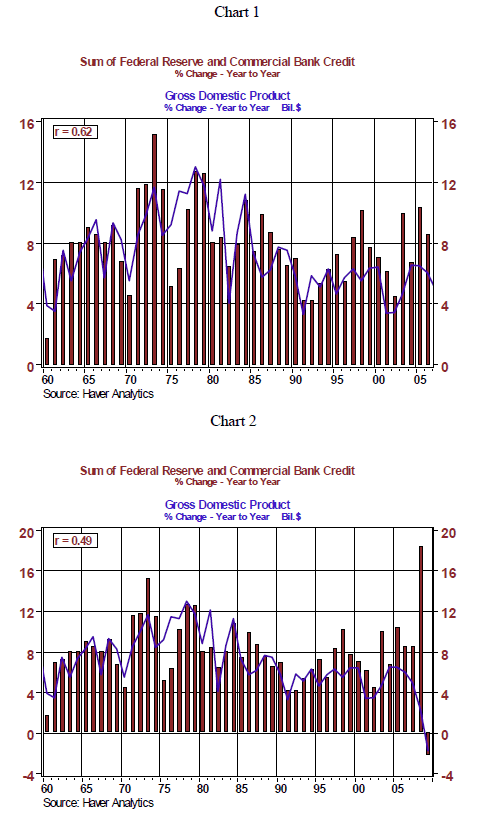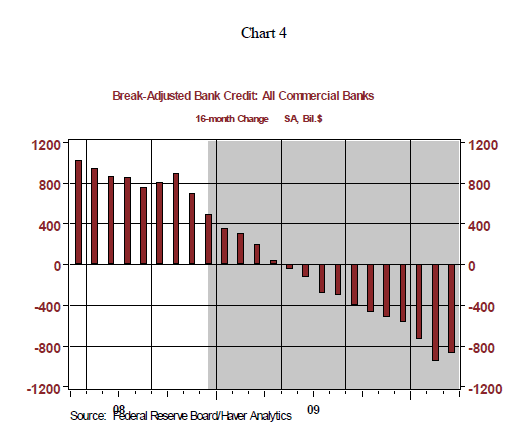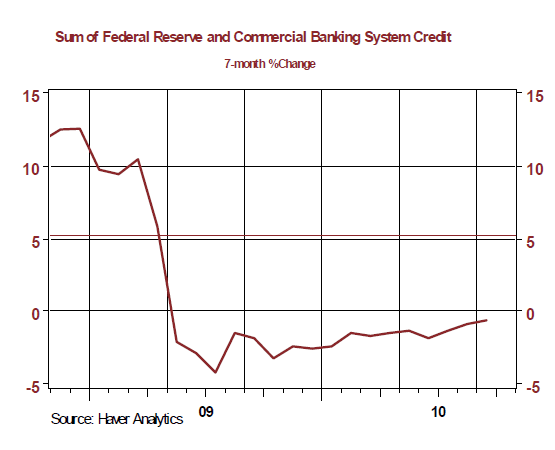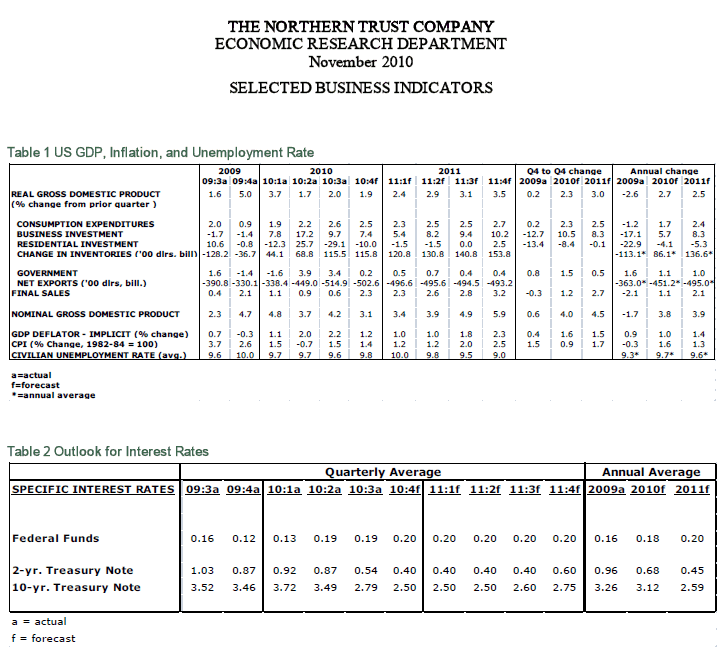20 June 2011 10:00
Because the Federal Reserve has become a political target, it is in no hurry to have monetary policy displace fiscal policy in underpinning the economy, but it may be forced to do so given its dual mandate and the likelihood of fiscal contraction. Last week, when discussing what QE3 could look like I indicated that were the Federal Reserve to start expanding its balance sheet, QE3 will see interest rate caps after a pause and period of reflection. Let me address the differences between the various QEs here to illustrate why interest rate caps are being contemplated.
QE1
The LSAPs were not aimed at supplying liquidity to financial institutions or at reducing systemic risk. Instead, they were intended to support economic activity by keeping longer-term private interest rates lower than they would otherwise be.
A primary channel through which this effect takes place is by narrowing the risk premiums on the assets being purchased. By purchasing a particular asset, the Fed reduces the amount of the security that the private sector holds, displacing some investors and reducing the holdings of others. In order for investors to be willing to make those adjustments, the expected return on the security has to fall. Put differently, the purchases bid up the price of the asset and hence lower its yield. These effects would be expected to spill over into other assets that are similar in nature, to the extent that investors are willing to substitute between the assets. These patterns describe what researchers often refer to as the portfolio balance channel.
-The Fed's Expanded Balance Sheet, Brian P. Sack, Executive Vice President, Federal Reserve Bank of New York, Dec 2009
I am not sure why Brian Sack stressed the Fed's intention to support economic activity as the chief aim of QE1 in December 2009. While I won't dispute a Fed official's interpretation of the Fed's intentions, it is abundantly clear that QE1 was a different animal than QE2. In QE1, the Fed purchased agency securities and mortgage-backed securities rather than Treasury securities as it did in QE2. This is significant as Fed Chairman Ben Bernanke was at pains to stress that QE1 was "credit easing", focused on the asset side of the balance sheet, and therefore distinct to what the Japanese had done. See the Bernanke speech at the LSE from January 2009. When he says "in addition to easing monetary policy, the Federal Reserve has worked to support the functioning of credit markets by providing liquidity to the private sector" at the 7-minute mark, it is clear to me that he means that credit easing has provided liquidity that the purchase of mere Treasury securities could not. Whether these asset purchases were "aimed at" providing liquidity is largely semantic.
In my view, the difference between Sack's commentary in December 2009 and Bernanke's in January 2009 owes to the political backdrop because bailouts of the financial sector had become extremely unpopular. During QE1, the Fed purchased $175 billion of agency debt securities and $1.25 trillion of mortgage-backed securities in addition to purchases of Treasuries. In effect, the Federal Reserve became the market as the shadow bank sector imploded. The mortgage-backed securities market had ground to a halt and the Fed took the entire market onto its balance sheet to prevent a second Great Depression.
So, if I had to characterize QE1 I would say: the first round of large scale asset purchases by the Federal Reserve was intended to support economic activity. However, because the Fed focused on the asset side in increasing its balance sheet by buying assets it had not previously purchased in large quantities, the Federal Reserve worked to support the functioning of credit markets by providing liquidity to the private sector. Without this easing, the US and the global economy would have had a depression of indescribable severity with unknown attendant geopolitical and military consequences.
Was QE1 a bailout? Yes. But QE1 was also a legitimate lender of last resort operation. We should question the terms of QE1 i.e. "The Fed lent freely, but at a low rate, on dodgy collateral" not the operation per se.
QE2
The second round of quantitative easing was distinct from the first – and more akin to what the Japanese had done. The aim was to support economic activity in the US domestic economy. Starting in August 2010, the Federal Reserve started reinvesting principal payments from agency debt and agency mortgage-backed securities that it had acquired in QE1 in longer-term Treasury securities. By November 2010, after the 2010 mid-term elections, the FOMC decided to expand its balance sheet by $600 billion through the purchase of Treasury securities.
But, as we have detailed many times here at Credit Writedowns, quantitative easing doesn't actually have an impact on the real economy. It is an asset swap. The Federal Reserve buys Treasury bonds and sells dollars it has created expressly for that transaction. After the asset swap, the balance sheet of the primary dealer which sold the Treasuries to the Fed has not increased; it now has cash instead of Treasuries. So there are more reserve deposits and fewer Treasuries in the private sector. The Federal Reserve has Treasuries instead of the money it created in expanding its balance sheet. While the reserves can ostensibly be lent out, the reality is that this money will sit in a bank vault idle unless the demand for loans warrants otherwise. It is a misunderstanding of how the banking system works to assume the mere creation of reserves has any significance regarding lending. I would argue the swap drains the economy of higher interest-bearing assets that add to income, replacing them with essentially non-interest bearing assets. Why would we want the Fed to conduct QE then if we know this will just create excess reserves as it did when the Fed began credit easing in QE1?
In particular, central bank purchases of longer-term securities work through a portfolio balance channel to depress term premiums and longer-term interest rates. The theoretical rationale for the view that longer-term yields should be directly linked to the outstanding quantity of longer-term assets in the hands of the public dates back at least to the 1950s.
-Unconventional Monetary Policy and Central Bank Communications, Janet Yellen
This is problematic because the Fed had intended to lower interest rates via the lowered risk premia. That was their stated purpose when they started QE. I know they talk only about having boosted asset prices now to prove QE2 was a success. But, initially, the Fed wanted to lower interest rates too. So while the Fed lowered risk premia, It is conceivable that accommodative monetary policy could provide tinder for a buildup of leverage". Moreover, the Fed's QE2 raised inflation expectations, causing interest rates to actually rise and working at cross-purposes with the lowered risk premia. Thus, QE2 was only successful insofar as it has increased business credit and raised asset prices. As we now see, the economy has actually cooled during QE2. So soon after I told you the QE2 trade was effectively over in late March, asset prices and bond yields started to come down as inflation expectations plummeted.
QE2 has been a bust.
"desperate measures for desperate times seems like the best characterization." I think we all agree here: It's totally ineffectual. It makes the Fed look like a bunch of amateurs.
-Let's talk about QE, inflation, and consumer demand, Marshall Auerback, Nov 2010
QE3
The FOMC has already considered offering unlimited quantitative easing to target specific interest rates and buying municipal bonds has been broached by well-connected Fed watcher David Blanchflower. I want to focus on the interest rate caps here because I believe this is politically more feasible, and therefore more likely.
When it comes to quantitative easing, we have to look both at the quantitative and the easing. Going back to the Fed's failure to reduce longer-term interest rates during QE2, it has more to do with the quantitative than the easing. Ultimately, one can influence the price or the quantity of something, but not both. And with QE2, the Fed decided to influence the quantity (of bank reserves), when its stated aim was to influence price (of money reflected by interest rates).
It is unlikely that the Fed will go back to the well for the same policy since QE2 has proved ineffective. So now that the economy is weak again, it will up the ante and target rates instead of specific easing quantities. This has the potential political benefit of the Fed's not having to expand its balance sheet. The Fed would essentially guarantee a rate and let the markets move interest rates to that level. Of course, the Fed would promise to defend the rate(s) if and when necessary. The Fed may be tested initially, but punters would lose their shirts fighting a market player with a potentially unlimited supply of liquidity. So I would expect the balance sheet effects for the Fed to be muted. And clearly, if QE3 reduced rates in addition to having largely the same impact as QE2 as well, it would be a more powerful tool.
There could be internal dissent to such an aggressive policy. I do not expect QE3 now nor do I expect it unless the economy deteriorates further. So the Fed could start off by signalling to the market that it will conduct what I have been calling 'permanent zero'. Look for how the Fed reinforces its commitment to "exceptional low levels for the federal funds rate for an extended period". If Bernanke is forceful about this commitment in this week's FOMC press conference, people will be forced to accept the likelihood of permanent zero and the term structure will flatten further and further out the curve.
I hope this post spells out the differences between the various QEs. QE3 is qualitatively different than credit easing (QE1) or quantitative easing (QE2). Let's call QE3 rate easing. And while we can hope the economy strengthens so that rate easing is unnecessary, the push for it is already well-advanced.












